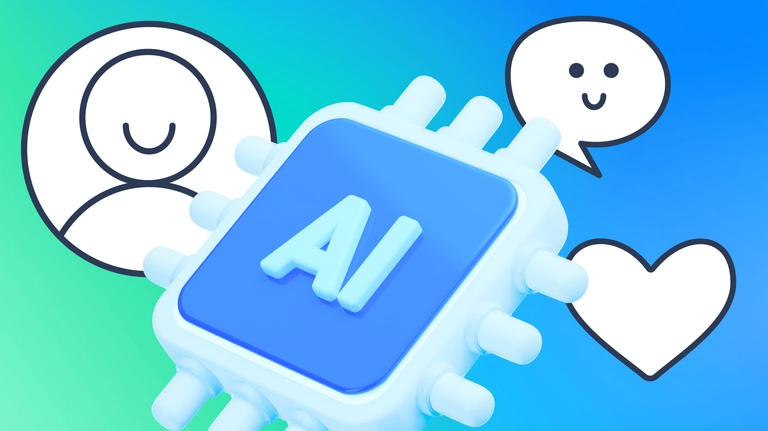
How AI can improve customer experience
Learn how businesses can leverage artificial intelligence to enhance customer experience.
Customer experience can either make it or break it. No matter how valuable and competitive a product or offering is, ultimately it all boils down to how people feel when they interact with a business. That is what defines if they'll stay or switch to competitors.
According to HubSpot, companies that provide great customer experience (CX) are more likely to get repeat purchases from 93% of customers and be recommended by 82% of customers. It is therefore no surprise that businesses across industries are increasingly putting the customer first. And forward-thinking businesses employ artificial intelligence to make the most of their CX initiatives.
In this article, we explore what is behind all that buzz about using artificial intelligence (AI) in an area that traditionally relied on human interaction – customer experience. Let’s find out how AI helps companies gain customers’ loyalty along with cutting service-associated costs.
What is AI CX?
AI CX (artificial intelligence customer experience) refers to the application of artificial intelligence to create more personalized, efficient, and satisfying experiences for customers at different stages of their journey. Artificial intelligence automates a huge chunk of customer service, allowing for shifting focus and effort from mundane and repetitive tasks to areas that require a human touch. It's somewhat paradoxical: integrating AI into customer service strategy actually enables businesses to prioritize customer centricity even more.
Understanding the technologies behind AI
To put it simply, artificial intelligence enables computers to perform tasks that previously required human involvement. This term encompasses a broad range of technologies, but we’ll not go too deep and explore just the ones that are actively used to make customers happy. Here they are:
Machine learning (ML) focuses on building computer systems that learn from data and improve their performance over time. Such systems analyze customers’ behavior to provide personalized recommendations and content, categorize customer inquiries by extracting keywords, and perform a whole bunch of other tasks that involve processing large amounts of data.
Natural language processing (NLP) enables machines to understand, interpret, and generate human-like text. This way, computers can figure out what users are asking, pick up on the emotions behind the words, and give meaningful and useful responses.
Predictive analytics uses statistical algorithms and machine learning techniques to identify patterns and predict what's going to happen next. With this powerful tool at hand, you can get a better understanding of customers’ needs and behavior and proactively address any issues before they become significant problems.
Speech recognition translates spoken language into text, enabling computers to understand and respond to voice commands in real time. This technology is used in virtual assistants, automated telephone systems, and voice-activated applications that let users control their devices with spoken commands.
These technologies define the applications of AI in customer experience and are increasingly utilized by companies to automate and streamline customer service.
4 ways to apply AI for customer experience
When it comes to customer experience, AI can work wonders.
- Enhance customer service with AI-powered chatbots and virtual assistants
Chatbots and virtual assistants are often the first things that come to mind when considering AI customer experience. They handle various tasks such as:
provide customer support 24/7 and answer questions instantly
redirect users to support agents if needed
book visits
facilitate onboarding

For instance, in Chatfuel, you can create a ChatGPT-powered assistant bot that will take care of all the mentioned tasks and more.
Speaking of measurable outcomes, chatbots also help to increase engagement, improve customer satisfaction, lower customer effort scores, and prevent churn.
Case in point: Interaksi, a service marketplace, used a WhatsApp bot to automate matching customers with service performers. What were the results? The customer-performer connection time decreased to 1 minute, improving application-to-deal conversion and performer retention. You can learn more about their AI journey here.
- Analyze customer feedback to find areas for improvements
Using AI for CX, you can pinpoint weak spots and identify areas for improvement in your overall strategy and business processes. For example, you can employ sentiment analysis technology to analyze customer feedback across various channels – from social media to customer reviews – to understand the emotion behind the words. With this wealth of knowledge, you can:
make data-driven decisions
prevent or lower customer churn
implement targeted improvements to eliminate bottlenecks
The result of these efforts is smoother journeys and better experiences for your customers.
- Enable more tailored experiences with personalized recommendations
AI algorithms can analyze huge amounts of user data, including past interactions, purchase history, and preferences, and then identify patterns. Based on these patterns, AI offers relevant and engaging content or products.
Companies across industries apply personalized recommendations to create a memorable and positive AI customer journey by demonstrating care and attention to individual preferences:
Amazon with its AI-driven personalized recommendations system analyzes buyers' shopping habits, the contents of their cart, and what other people are buying to provide them with tailored product recommendations
Spotify uses artificial intelligence to create unique playlists based on the listener's recent listening habits
But personalized recommendations impact goes beyond elevating overall satisfaction. It also positively affects more down-to-earth aspects of business:
boost sales by presenting customers with options that are more likely to resonate with their interests
provide tailored retention offers
increase customer engagement and encourage further interaction with your brand
- Forecast future customer behavior with predictive analytics
Understanding how customers behave is the key to providing them with the best possible experiences. Here is where predictive analytics comes in handy. It analyzes historical data, identifies patterns and trends, and accurately forecasts future customer behavior. This helps identify potential churn risks, enabling you to implement retention strategies and keep customers.
Additionally, predictive analytics allows for a more efficient allocation of resources. This may include optimizing inventory levels, adjusting customer service staffing based on expected demand, tailoring promotional activities, and so on.
What is the future of AI in customer experience?
As technology continues to advance, we are likely to discover new exciting ways how AI technology will transform customer engagement. Meanwhile, here are the key AI trends that we are witnessing now or can expect soon:
Increased chatbot usage. One of the clear trends of AI in CX is the growing use of chatbots. Here you can learn more about why and how businesses use chatbots for marketing, customer support, and sales.
More accurate predictive capabilities. As artificial intelligence improves, it can predict what customers will need and how they will behave more accurately. This could enable even more tailored, hyper-personalized customer experiences.
Emotion AI. Humans are really good at understanding and caring about customers, dealing with problems, and meeting individual needs – something AI still struggles with. However, as computer vision technology continues to evolve, we can expect the emergence of service tools capable of recognizing and reacting to human emotions conveyed through facial expressions or tone of voice. This will enable understanding and empathetic interactions with customers.
Voice and visual search. Voice and visual search are set to become more common in improving the customer experience. Customers will be able to interact with businesses using voice commands or images, making the search and purchase processes easier and faster.
There may appear way more options to combine AI and customer experience. What is clear is that the most successful results of this collaboration are achieved through a partnership between humans and AI. When it comes to customer journey, AI can be super effective, but at the end of the day, it's us humans and our emotional intelligence that really steer the ship.
Summary
By making customer experience better, automating processes, and cutting down on service-related costs, artificial intelligence brings lots of advantages to businesses and their customers. The key to pulling off a successful AI project is to clearly set out your goals and choose the right technology to get the job done.
Now that you know how to use AI to improve the customer experience, you may want to start your own AI initiative. Introducing a chatbot is the simplest way to incorporate artificial intelligence into your business. The best part is that enabling a chatbot doesn't require significant investments or technical proficiency – with tools like Chatfuel, you can get your first AI-driven bot up and running with just a few clicks. Get a free trial to try out AI in customer experience.
